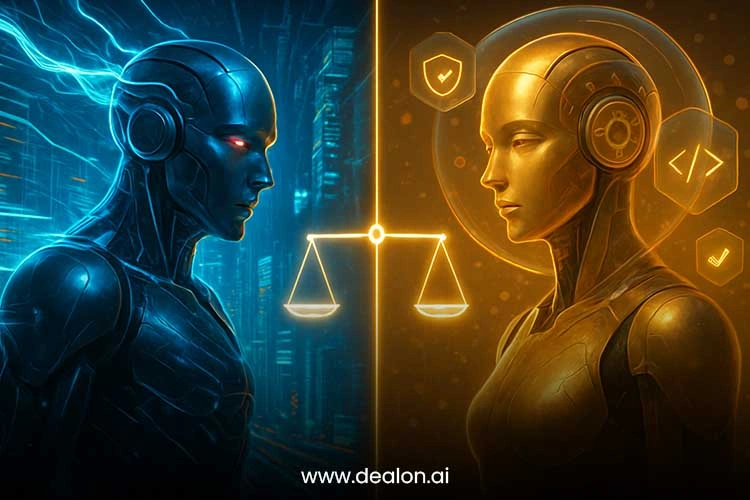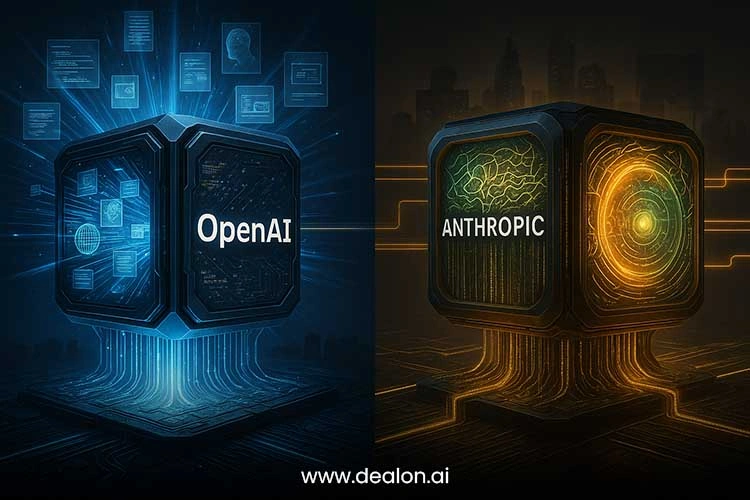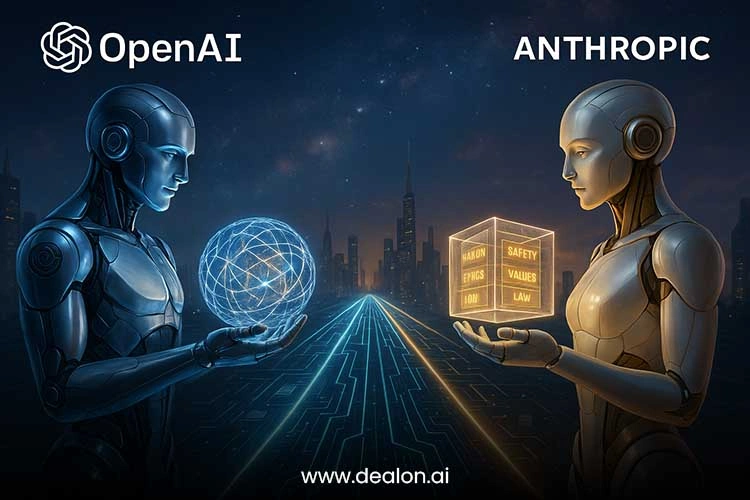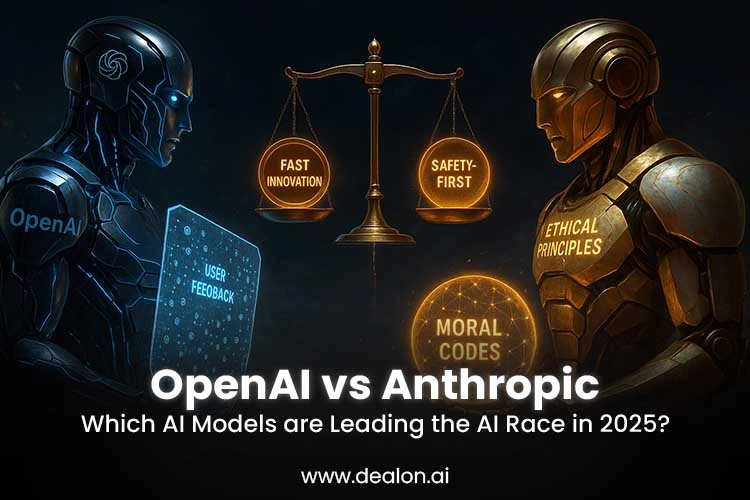OpenAI and Anthropic are among the first movers delving into a similar but independent technological renaissance that is going to redefine the limits of human and machine collaboration. The universal enthusiasm about AI has found its way beyond the scientific laboratory and is ingrained in the cultural, economic, and political discourse of the present time. But as algorithms become more intelligent and people-like, they are also getting more human, more able to create and think with flair and nuance, the question only gets sharper: Who makes the future of this mind-altering technology?
The competition between OpenAI and Anthropic can be seen as more than just a race to ever-greater computational power in artificial intelligence development; it involves a divergence in philosophies as to how artificial intelligence should be developed and deployed, as well as how it should be secured. To achieve its grand vision of creating artificial general intelligence, in the best interest of the whole human race, OpenAI has pursued the policy of fast feedback, as well as global connection.
By contrast, Anthropic has adopted a more cautious (or, by some definitions, more safety-oriented) approach, coining the notion of the so-called constitutional AI that would concern each layer of the model training and decision-making process with guiding principles.
What is so interesting in this competition is that this corporate drive looks beyond its interest and explores these notions of morality, power, and trustworthiness. OpenAI and Anthropic represent two opposite poles: one aims to move the field of AI more quickly and open up new models to broader audiences, and the other wants to slow its pace due to limitations that need to be addressed, in particular, alignment and responsibility. With the release of ever more capable systems by these organizations, in the form of multimodal chatbots or long-contextual reasoning engines, their methods will leave their mark on the course of science, business, and governance in the digital era.
As this article will show, the philosophies of these two tech giants, the technological breakthroughs, and the influence they have had on society all differ, making it extremely difficult to determine who is actually pioneering the AI race.
Read Also: Agentic AI vs Generative AI Model: The Key Differences Explained In 2025
The Philosophical Split: the Ambition of an Action vs. the Safety-First Consideration

The divergent views held by OpenAI and Anthropic can be traced to an ideological gulf that best describes their differing vision for the future of artificial intelligence. OpenAI has been driven by a lofty goal from the very beginning, sometimes even utopian, an AI that is for the good of ordinary people and can be used to supplement human abilities on Earth.
This approach has guided the direction of the organization since it has been characterized by a high level of iterative development, open dialogue with the public, and a willingness to incorporate cutting-edge models like GPT-4 and GPT-4o into the hands of developers, seekers of innovations, and companies globally. As a result of such a strategy, an ecosystem has been catalyzed that values innovation velocity and democratization more than caution.
Anthropic, by contrast, came into being by opposition to this spirit. Anthropic was founded by former OpenAI researchers who became disillusioned with the progress of unregulated AI and promote the philosophy of constitutional AI. This paradigm incorporates moral principles into the learning process itself so that ethical values of a just, transparent, and non-homicidal character are built into the resulting models. In that work, they articulated the view that building truly transformative AI serendipitously requires putting in place safeguards as fundamental as the algorithms that are implemented.
This variance has a far-reaching impact beyond product roadmaps. It poses serious issues of whether humanity should proceed in the name of optimal functionality and high-volume accessibility or mandate a probably slower and incremental approach aimed at protecting human safety with higher priority over velocity. The bottom line is that OpenAI is a Promethean organization that needs to disrupt the status quo in order to improve it.
In contrast, Anthropic is the cautious caretaker who tries to engineer the necessary safety measures and usher out the AI safely into the world. The interplay of these philosophies not only influences corporate strategic decisions; they are beginning to construct the moral landscapes in an age where intelligent systems will infiltrate all areas of the human sphere.
Technological Prowess: Models That Influence the Industry

The recent technological battle between OpenAI and Anthropic is essentially a presentation of two opposite approaches to engineering in terms of their practical application to the interaction between human beings and machines. OpenAI has established itself as an organization with an impressive reputation due to the rate of innovation combined with the level of sophistication on an architectural plane. Demonstrating the ability to process multimodal inputs, including text, vision, and even audio-based signals smoothly, models like the GPT-4 and GPT-4o show signs of creating an experience that is more human and intuitive than their previous models.
This scope is further expanded with the fact that OpenAI is the Microsoft strategic alliance, which will see GPT technology built into its products, such as the Office and Azure, thereby dissipating the notion of AI being a curious experiment into a daily assistant. Beyond textual scale, OpenAI systems have led to the emergence of capabilities such as reasoning chains, synthesis of code, and adaptive creativity. These possibilities have positioned GPT as one of the fundamental platforms of startups and companies seeking to develop AI-native applications.
Claude, the flagship model of Anthropic, indicates a composed yet extremely well-developed set of solutions. Open AI has a bias toward breadth, and Claude is biased toward depth of cognition (long-context comprehension, very high coherence over long dialogues, almost literary sensibility in its production). The architecture of the model is designed with safety being overlaid on all levels of the process, which makes the responses of the model beautiful in industries where the fidelity and risk requirements are high, i.e., legal analysis, research, and knowledge-intensive customer support.
Ideally, it is now breadth versus refinement in the competition. The models produced by OpenAI are leading due to their broad capabilities and pervasiveness, and Anthropic is closing at a furious pace with their comprehensive fine-tuning. This clash of two approaches to intelligence represents two visions of how the scope of intelligence can be extended: one upward, to encompass as much variety of domains as possible (the great encyclopedist), and the other downward, to constitute perfection in the very quality of reasoning (the great logician).
AI Safety and Alignment: The Battle Ground Definer

In an increasingly automated world, where technology can initiate significant changes in a company, safety and alignment are emerging as the most essential differentiators. The time is gone when AI ethics was regarded as slightly off-topic; now it is positioned at the centre stage where credibility and reception depend.
OpenAI has devoted much effort to reinforcement learning through human feedback (RLHF) to teach their models what behavioral norms are. The method enables such a system as GPT to learn through collated examples of what humans find acceptable, step by step, aligning the texts it produces with the expectations of users. OpenAI also applies multi-level safety, moderation functionalities, and red-team procedures in anticipation of abuse. However, as seen in the past, OpenAI systems can at times go awry, producing offensively unexpected or borderline content when prodded to the limits of their functionality, not anomalous in systems taking an evolutionary path in response to increased demands.
On the other side, Anthropic has a different view on safety and treats it as an architectural value, not as a piecemeal solution. The AI has been codified with ethical priorities like honesty, fairness, and harm avoidance in its constitutional AI framework, which has been directly incorporated into its training. Rather than simply using external guardrails, Anthropic aims to internalize normative reasoning such that the outputs would be more coherent and not likely to exhibit poor or biased behaviour. This disparity has been what has made Organizations with rigorous compliance requirements turn to Anthropic as a partner, going from healthcare providers to policy institutes.
This conflict of alignment is no more and no less a technical one, but is a philosophical one. It discusses one of the more profound questions: whether AI safety should be responsive or one refined after the action begins, or have a proactive nature, installed at the inception. In this area, Anthropic-style principled action is a long game. In contrast, OpenAI-style fast iteration sees this as the cost of doing business, and exposure and use are their way of strengthening models over a given timeframe. Trust is coming to be one of the most critical factors in the contest as the stakes of AI misuse continue to rise.
Market Growth and Ecosystem Development
In addition to the technical expertise, the scope of both OpenAI and Anthropic can be determined by the communities they build and the partnerships they establish, and how their innovations enter industries and society. With the strategic investment in Microsoft, OpenAI has created a massive ecosystem that is more powerful and is everywhere. Its APIs and models are integrated into the productivity suites, cloud infrastructure, educational platforms, healthcare solutions, and fintech applications, and they streamline workflows in a near-imperceptible fashion.
With Azure, OpenAI will have access to a scale available all over the world, which also means its findings will not be restricted to labs, but will be incorporated into daily software, such as a home tutoring service and an information aggregator used by businesses. There is a solid community engagement and brand awareness that has been created by its developer-first approach, maximizing the potential of its technology in its adoption at an unprecedented rate.
Anthropic, on the other hand, has been quite discerning and selective when expanding. The network of partnerships that Anthropic is building with substantial funding from Google and Amazon is prioritizing trustworthiness, compliance, and ethical use over pace. This has been used to position its main product, Claude, as a preferred option for companies that are in industries where the concern about regulations and reputation is critical. Anthropic will not flood the market, but instead, will affect it by seeking partnerships with businesses that follow its vision of safety and transparent governance of AI.
The market dynamics paint a picture of how two different approaches, such as expansive and integrative ones on the one hand and precise and principled ones on the other hand, will fare. OpenAI would like to integrate its models into the online world as soon as possible, whereas Anthropic would much rather create a fortress of credibility where gradual growth will ensure long-term impact. With the growing demand for AI, the competing strategies can become a factor that defines not only the market share but also the level of trust.
Who Is Winning?
Trying to call out a clear winner in the OpenAI versus Anthropic challenge would be an oversimplification of a contest that has more of a symbiotic character than an antagonistic one. Winning, in this context, is multidimensional because it depends on how you value the technological spread of AI models, ethical responsibility, and their long-term implications.
In terms of innovation speed and market saturation, OpenAI enjoys a significant advantage. Its models have become extensively incorporated into popular tools that define workflows in education, finance, healthcare, entertainment, and almost every other field. The partnership with Microsoft has successfully turned GPT-driven models into invisible co-pilots for millions of users, giving OpenAI an influence that very few companies in the history of technology have achieved.
Nevertheless, when it comes to ethical governance and alignment, Anthropic markets its models as the moral leadership of the artificial intelligence business. By not wanting to equate speed with progress, Anthropic gives models that are always made through lenses of safety, interpretability, and human values. This has given credibility to Claude and Anthropic, who have come out with models that are held in high regard, especially in areas where high risks are involved.
This can be the final realization of this challenge: that no champion can be seen. The two approaches are instead acting as countervailing powers. OpenAI is expanding the envelope with impressive models, and defining an intense moral center for the models is what Anthropic is doing. This process forms a dialectic of evolution, where the industry will necessarily have to innovate in a way that can be called responsible, but will be required to question its assumptions. Their competition is not zero-sum; the final scene can be a more balanced future where models will portray both capacity and conscience, and AI would serve the ambition and humanity.
Conclusion
The relationship between OpenAI and Anthropic offers another demonstration of how the revolution of AI is also a philosophical debate as well as a technological race. The grand vision of OpenAI has indeed democratized advanced AI models, and they are embedded across sectors, where they are speeding innovation at an unprecedented rate. Anthropic, by valuing the concepts of constitutional AI, especially, has placed itself in a role of enforcing ethical boundaries, putting safety before speed of deployment, and implementing interpretability as a core idea.
The two approaches, broad versus the very patient and principled, are not incompatible as such and are more likely to create a balanced tension that drives artificial intelligence and its models into the future, but keeps the risks in the background. The question of who is leading cannot be narrowed down to the metrics. Instead, it is a figurative war between ambition and caution that will make the future of AI not only powerful but also human-centered as it ushers in the age of technology characterized by a balance of innovation and responsibility.

